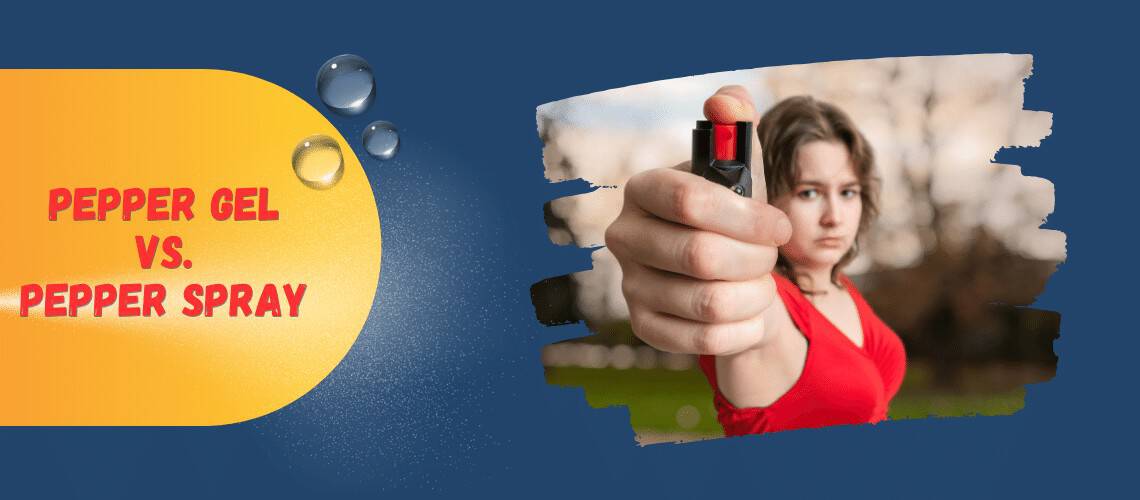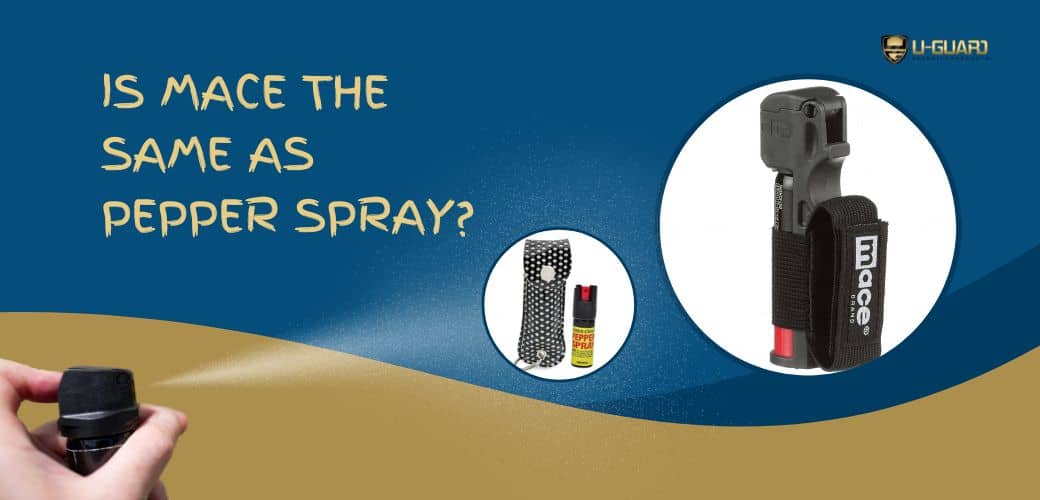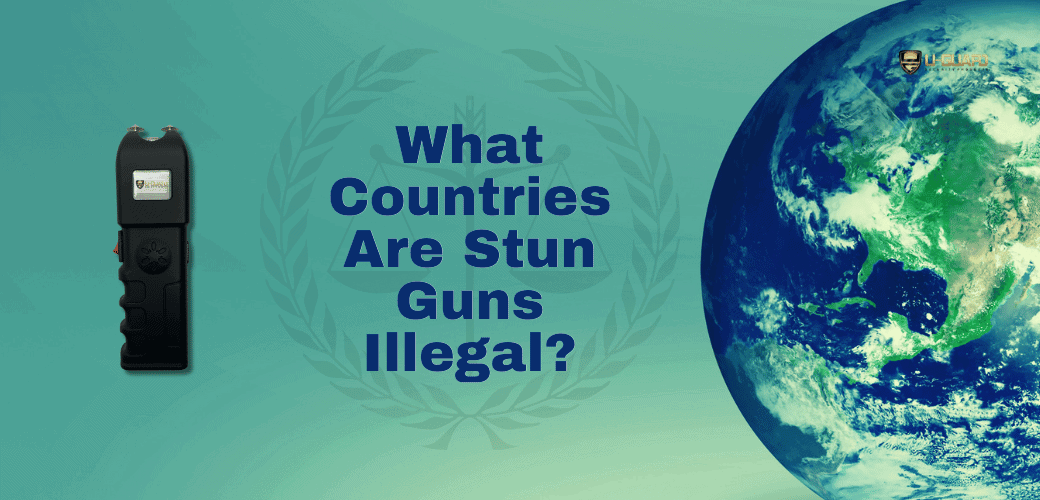When it comes to self-defense options, pepper gel and pepper spray are two popular choices. Both are effective at deterring attackers by causing temporary discomfort and inflammation. However, there are some key differences between the two that may impact your decision on which to use in a given situation. In this blog post, we will delve into the specifics of pepper gel vs spray, including their range, effectiveness, and recommended uses.
Understanding the Basics: Pepper Gel and Pepper Spray
Both pepper gel and pepper spray are formidable self-defense tools, utilizing the potent effects of oleoresin capsicum, derived from chili peppers, to incapacitate potential threats. This compound inflicts an intense burning sensation on the skin, in the eyes, and can significantly impair breathing, providing a non-lethal means to halt an aggressor in their tracks. The primary distinction between the two lies in their dispersal methods. Pepper spray is emitted as an aerosol, creating a mist that can cover a broader area. This form allows for rapid deployment, potentially affecting multiple targets or creating a barrier of protection. On the other hand, pepper gel is dispensed as a thicker, viscous substance. Its gelatinous consistency ensures that upon impact, it sticks to the target, reducing the chance of affecting unintended individuals or areas. This stickiness not only minimizes the risk of contamination to bystanders but also prolongs the incapacitating effects on the assailant, as it is harder to quickly remove or brush off. This foundational understanding of how each tool operates is crucial for anyone considering adding pepper gel or spray to their personal safety arsenal.
The Distance Debate: Does Pepper Gel Shoot Farther?
A critical factor to consider when choosing between pepper gel and pepper spray for self-defense is their effective range. The design and mechanics behind pepper gel allow it to achieve greater distances compared to its spray counterpart. Due to its thicker, more cohesive substance, pepper gel can be propelled over longer distances without significant dispersion or dilution by the wind. This aspect makes it an ideal choice in open spaces or when a precise, targeted response is necessary. Unlike the mist-like dispersion of pepper spray, which can be unpredictable in windy conditions and may not reach as far, pepper gel’s stream remains compact and directed. This concentrated delivery system not only enhances the user’s ability to hit a distant target but also reduces the chances of collateral impact on nearby individuals or objects. The ability to maintain control over the substance’s trajectory and minimize environmental interference positions pepper gel as the superior option for those prioritizing range in their self-defense strategy. This extended reach can provide a significant tactical advantage, allowing the user to maintain a safer distance from a potential threat while still deploying an effective deterrent.
Precision and Blowback: The Advantages of Pepper Gel
The standout feature of pepper gel lies in its remarkable precision. This precision is largely attributed to the gel’s viscosity, which allows it to be directed accurately at a target with minimal risk of deviation. This attribute is crucial in high-stress situations where accuracy can make a significant difference in the outcome. Unlike aerosol sprays, which can disperse widely and unpredictably, particularly in windy conditions, pepper gel’s trajectory remains steady and focused. This ensures that the intended target is the primary recipient of its effects, maximizing the defensive action’s effectiveness.
Another critical advantage of pepper gel is its reduced susceptibility to blowback. Traditional pepper sprays, when used against the wind, pose a risk of affecting the user due to their mist-like dispersion. This can be particularly concerning in scenarios where self-defense becomes necessary, as impairing one’s own vision or respiratory function can be debilitating. Pepper gel, however, largely mitigates this concern. Its stickier formulation means that even when deployed in breezy conditions, it is less likely to be blown back towards the user. This characteristic not only enhances the safety of the defender but also ensures that the product’s incapacitating effects are reserved almost exclusively for the aggressor, thereby providing a clearer advantage in personal safety measures.
The Versatility of Pepper Spray in Various Situations
Pepper spray stands out for its adaptability in various defensive scenarios. Its aerosol nature allows for swift and broad coverage, making it particularly useful in encounters with multiple assailants. This characteristic enables the user to quickly create a defensive perimeter or barrier, offering a chance to escape or seek help. The widespread dispersion of pepper spray can also be advantageous in situations where precise targeting is challenging, such as in low visibility conditions or when an assailant is moving erratically. This tool’s ability to cover a larger area with minimal effort ensures that, even without direct hits, it can still disorient and deter attackers, providing crucial moments for the user to act. Furthermore, in enclosed spaces or when surprise is a factor, the immediate deployment capability of pepper spray can disrupt the threat’s ability to advance, serving as a critical component in personal safety strategies. Its ease of use, combined with the ability to affect a wide zone, renders pepper spray an essential option for those seeking a reliable and versatile means of protection in unpredictable and dynamic situations.
Home Safety and Security: Gel vs. Spray Indoors
When considering the implementation of pepper-based defense tools for indoor environments, the distinctions between pepper gel and pepper spray become particularly relevant. Inside a home, the risk of collateral impact on family members, pets, and property must be carefully weighed. The unique properties of pepper gel offer a solution with its minimized risk of airborne contamination. Its adherence to the target reduces the likelihood of the active compound becoming aerosolized and spreading through HVAC systems or lingering in the air, which is a concern with traditional pepper spray. This characteristic makes pepper gel a compelling choice for those concerned about indoor air quality and the safety of bystanders.
In contrast, while pepper spray’s broader dispersal pattern can be an asset in confronting multiple threats, its use indoors might inadvertently affect non-targeted areas or individuals. The fine mist created by pepper spray can quickly fill a room, potentially exposing all occupants to its effects. This makes it less ideal for confined spaces where control over the substance’s spread is paramount.
Given these considerations, selecting pepper gel for home defense allows for more controlled and focused use, making it suitable for scenarios where precision and the safety of other household members are top priorities. Its effectiveness in sticking to the aggressor without extensively contaminating the surroundings offers a balanced approach to indoor self-defense, aligning with the needs of homeowners seeking to protect their living spaces without undue risk to others.
Law Enforcement Preference: Gel or Spray?
The choice between pepper gel and pepper spray within law enforcement circles is guided by tactical considerations and the nature of the engagement. For individual self-defense, officers might lean towards pepper gel due to its precision and minimized risk of blowback, ensuring they maintain control in close encounters. In contrast, when addressing crowd control situations, the broader dispersion offered by pepper spray becomes invaluable. This allows for the quick establishment of a perimeter and the ability to disperse or deter large groups efficiently. Additionally, environmental conditions play a significant role in this decision. Officers operating in outdoor settings with variable wind conditions may prefer the stability and reach of pepper gel. Conversely, in confined spaces or situations requiring immediate area coverage, pepper spray’s rapid deployment capabilities offer a strategic advantage. The training, experience, and situational assessment of law enforcement personnel greatly influence their preference, with many agencies providing both options to accommodate the diverse range of challenges officers face on the field.
Making Your Choice: When to Use Pepper Gel Over Spray
Deciding between pepper gel and pepper spray involves evaluating the nuances of each option in relation to your unique requirements and the environments you’re likely to encounter. Pepper gel shines in scenarios where distance and precision are critical. Its ability to project a concentrated stream with minimal risk of wind blowback makes it ideal for outdoor use or when you need to keep a safe distance from a potential threat. This option is particularly valuable if you’re concerned about maintaining accuracy and minimizing the risk to others around you and weather conditions..
On the other hand, pepper spray offers advantages in situations requiring immediate, widespread coverage. Its capacity to swiftly create a barrier makes it suitable for unexpected encounters or when facing multiple aggressors. The aerosol form’s quick dispersion can be a vital asset in creating an opportunity for escape or disorientation of the attacker(s), especially in close quarters or when visibility and aim are compromised.Your choice may also hinge on considerations such as the ease of carrying and deploying the product, potential legal restrictions in your area, and your comfort level with the mechanism of each option. Weighing these factors will guide you towards the most appropriate self-defense tool, ensuring you have the means to protect yourself effectively in any situation you face.





